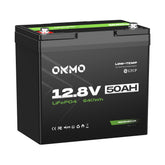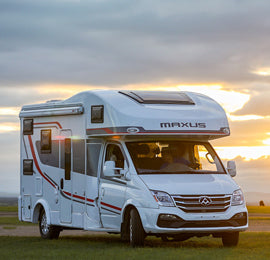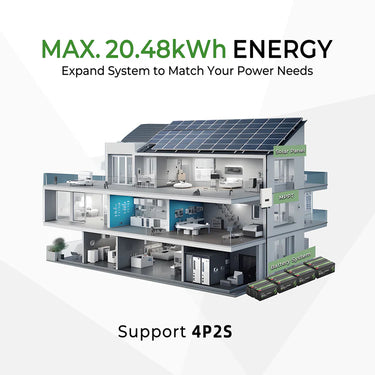5 Ways to Charge Your RV Battery: A Survival Guide for Your Rig's "Lifeblood"
 3 AM in a Colorado wilderness campsite, pitch black. The fridge stopped working, my phone was dead, and that glaring red battery icon on the control panel pronounced my complete "power death sentence." Shivering in my sleeping bag, I swore to the dark RV ceiling: I would never let a dead battery become the nightmare of my wilderness adventures again!
3 AM in a Colorado wilderness campsite, pitch black. The fridge stopped working, my phone was dead, and that glaring red battery icon on the control panel pronounced my complete "power death sentence." Shivering in my sleeping bag, I swore to the dark RV ceiling: I would never let a dead battery become the nightmare of my wilderness adventures again!
As an RV blogger constantly "on the road," battery life used to be my biggest demon. After trying countless methods and stepping into more than a few pitfalls, I finally discovered five truly reliable ways to keep the power flowing. Among them, building a custom power station using LiFePO4 batteries completely revolutionized my energy freedom! Each method has its strengths, like different tools in my kit, all essential for life on the move:
 1. The LiFePO4 Power Station: Your Custom "Mobile Power Fortress" (Highest Autonomy, The Future)
1. The LiFePO4 Power Station: Your Custom "Mobile Power Fortress" (Highest Autonomy, The Future)
-
Core Concept: Utilize high-energy-density, long-life, deep-cycling LiFePO4 (Lithium Iron Phosphate) battery packs as the core storage, combined with solar panels and shore power for charging, creating an independent, flexible, and powerful power system.
-
How to Build It:
-
The Core: Choose a LiFePO4 battery pack with suitable capacity (e.g., 100Ah, 200Ah, or larger). Strongly recommend choosing products with a built-in Smart Battery Management System (BMS) for safety (overcharge, over-discharge, overheating protection).
-
Charging Inputs:
-
Solar: Connect rooftop or portable solar panels via a high-quality solar charge controller (MPPT is more efficient) to convert sunlight into stored energy.
-
Shore Power: When plugged in at a campground, use the RV's built-in converter/charger or a dedicated multi-stage lithium charger to rapidly replenish the power station. LiFePO4 typically charges much faster than lead-acid batteries.
-
Vehicle Charging (Optional): Use a high-quality DC-DC charger specifically designed for lithium batteries to charge the station while driving (ensure your vehicle's electrical system can handle it).
-
-
Output: The station powers RV AC appliances (like microwaves, kettles, air conditioners requires large inverter & battery) via an inverter (converts DC battery power to AC). It also provides DC output for USB devices, lights, water pumps, fridges, etc.
-
-
Advantages:
-
Exceptional Charge/Discharge Efficiency: LiFePO4 can be deeply discharged (80%-90% Depth of Discharge - DOD) without damage, offering far more usable capacity than lead-acid (typically only 50% DOD).
-
Ultra-Long Cycle Life: 2000-5000+ cycles are common, multiples of lead-acid lifespan, making it a high long-term value investment.
-
Lightweight & Compact: Same capacity weighs about 1/3 of lead-acid, saving precious RV space and payload.
-
Nearly Maintenance-Free: No need for periodic fluid checks or equalization charges like lead-acid.
-
Wide Temperature Tolerance: More stable and safer in both high and low temperatures compared to other lithium types.
-
Silent & Zero Emissions: Completely quiet operation, no pollution, usable anywhere (even in generator-free zones).
-
Highly Flexible & Scalable: Capacity can be increased (parallel battery packs), multiple input/output options.
-
-
Disadvantages:
-
Higher Initial Investment: The LiFePO4 batteries themselves and the required high-quality chargers/inverters cost significantly more than lead-acid systems.
-
Requires Some Knowledge for Setup: While modular products are increasing, correctly selecting components, wiring, and setting parameters still requires research or professional help to ensure safety and efficiency.
-
-
My Real-World Test: Camped for a week straight in Utah's Canyonlands National Park. Relying on 400W of rooftop solar and a 200Ah LiFePO4 station fully charged before departure, I easily powered the fridge, laptop, LED lights, phone charging, and a low-wattage rice cooker. No generator roar, just pure wilderness tranquility. After discharging to 85%, one sunny day almost fully recharged it. This is, in my view, the ultimate RV power solution!
 2. Solar Power System: The "Silent Guardian" of the Wild (Best Partner for Your Power Station)
2. Solar Power System: The "Silent Guardian" of the Wild (Best Partner for Your Power Station)
-
Role: The primary energy source for your LiFePO4 station (especially off-grid), providing free, continuous power input.
-
Integration: Solar panels charge the LiFePO4 battery directly via an MPPT charge controller. LiFePO4 requires precise charging voltage, so a lithium-compatible (or programmable) solar controller is mandatory.
-
Pros: Free, silent, automatic, sustainable. Maximizes sunlight.
-
Cons: Weather dependent, low efficiency on cloudy/rainy days. Requires sufficient panel wattage to match battery capacity.
-
Upgrade Tip: Adding solar to your LiFePO4 station is key for boosting off-grid capability. Consider portable panels for extra flexibility.
 3. Shore Power Connection: The "Full Recharge" Oasis (Rapid Refuel for Your Station)
3. Shore Power Connection: The "Full Recharge" Oasis (Rapid Refuel for Your Station)
-
Role: Provides the fastest, most stable charging for your LiFePO4 station, especially after prolonged bad weather or before high-demand usage.
-
Integration: When plugged in, the RV's converter/charger (must support lithium charging profiles) or a dedicated lithium charger rapidly charges the station. LiFePO4 handles higher charge currents, reducing charge time.
-
Pros: Stable current, extremely fast charging. Gets your station "fully juiced" quickly.
-
Cons: Completely reliant on campground facilities and fees.
-
Critical Point: Confirm your converter/charger is fully compatible with LiFePO4 batteries! Older lead-acid chargers may not charge correctly or could damage lithium batteries.
 4. Vehicle Engine Charging: "Mid-Journey Top-Up" (Auxiliary Input for Your Station)
4. Vehicle Engine Charging: "Mid-Journey Top-Up" (Auxiliary Input for Your Station)
-
Role: Provides supplementary charging for your LiFePO4 station during long drives.
-
Integration: Connect the vehicle's starter battery (or alternator) to the LiFePO4 house battery using a DC-DC charger designed for lithium batteries. This is essential! Standard isolators or the RV's built-in charging circuit are usually too weak and unstable for effective, safe LiFePO4 charging. A DC-DC charger boosts voltage, regulates current, and efficiently utilizes drive time.
-
Pros: Leverages travel time for charging.
-
Cons: Efficiency depends on drive duration and DC-DC charger power. Increases vehicle fuel consumption and load.
-
Key Reminder: For charging a LiFePO4 station while driving, installing a proper DC-DC charger is non-negotiable!
 5. Gasoline/Propane Generator: The "Last Resort" Emergency Backup (Minimal Mention)
5. Gasoline/Propane Generator: The "Last Resort" Emergency Backup (Minimal Mention)
-
Placement: Solely for extreme situations: prolonged bad weather (no sun), critically low station power, and inability to reach shore power. For those with a LiFePO4 + solar setup, its use should be rare.
-
Operation: Start the generator → It powers the RV's converter/charger to charge the LiFePO4 station (again, verify charger compatibility!).
-
Pros: Weather-independent, high power, fast charging.
-
Cons: Noisy, requires carrying fuel, produces emissions, subject to campground restrictions, requires maintenance.
-
Reality Check: With larger LiFePO4 capacities, improved solar efficiency, and more campgrounds banning/restricting generators, their necessity has drastically decreased. I view them strictly as a "just in case" backup, not a primary solution.
The true essence of power freedom lies in evolving your core system. Under the Joshua Tree stars, the LiFePO4 station silently releases energy harvested by solar panels by day, powering string lights and the fridge's hum. At the tail end of Alaska's rainy season, a station "fed" full at a powered site sustained me through the final gloomy days. And cruising Route 66, the DC-DC charger worked silently under the hood, adding bricks to my power fortress mile by mile.
 Moving from relying on scattered charging methods to building an intelligent power ecosystem centered on a LiFePO4 station – this is my ultimate answer to "energy freedom." It's quiet, powerful, and autonomous, letting me focus on the view outside, not the battery gauge. When lights shine steadily on a late-night campsite and the coffee maker brews on cue in the wild dawn, that uncompromised ease is the purest poetry of RV life. Has your power core evolved yet?
Moving from relying on scattered charging methods to building an intelligent power ecosystem centered on a LiFePO4 station – this is my ultimate answer to "energy freedom." It's quiet, powerful, and autonomous, letting me focus on the view outside, not the battery gauge. When lights shine steadily on a late-night campsite and the coffee maker brews on cue in the wild dawn, that uncompromised ease is the purest poetry of RV life. Has your power core evolved yet?








